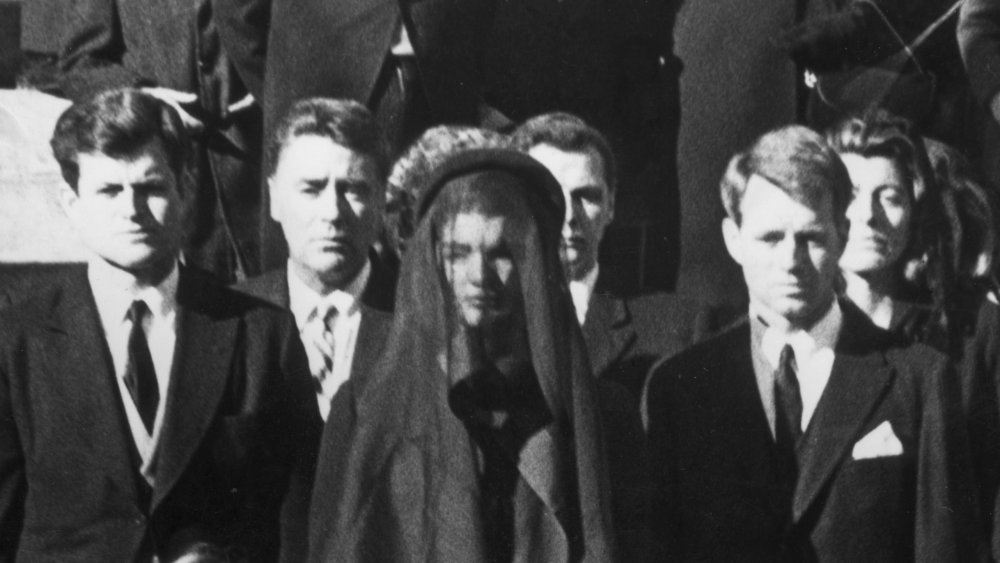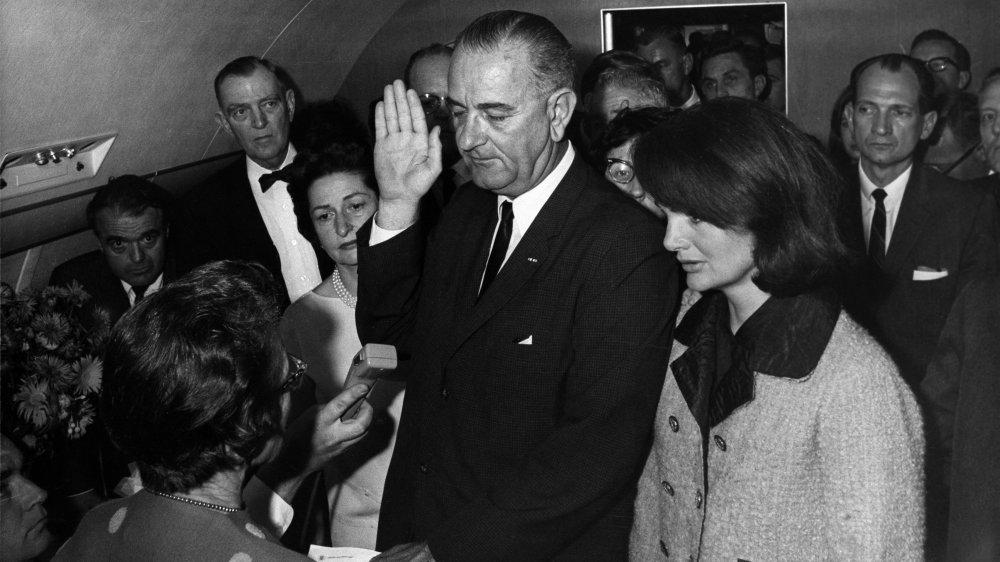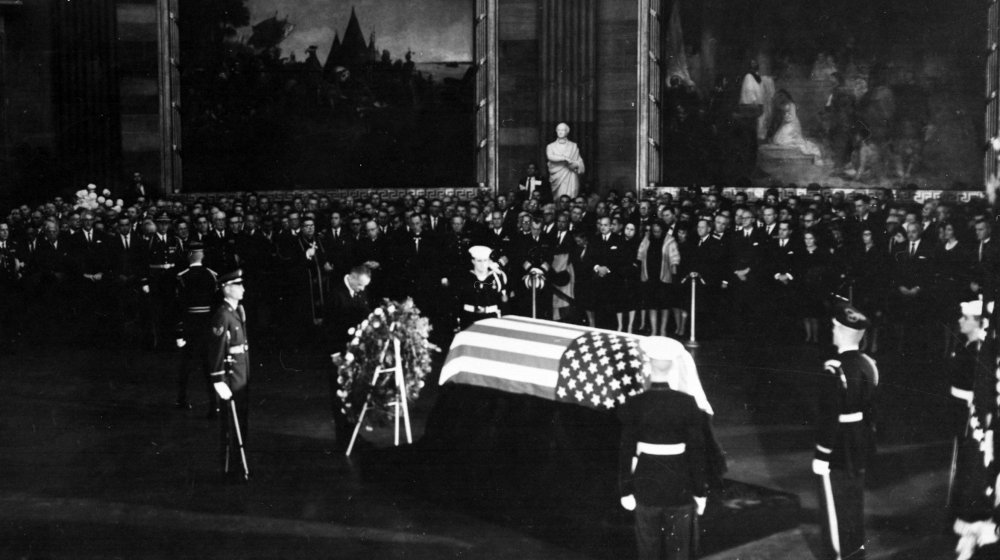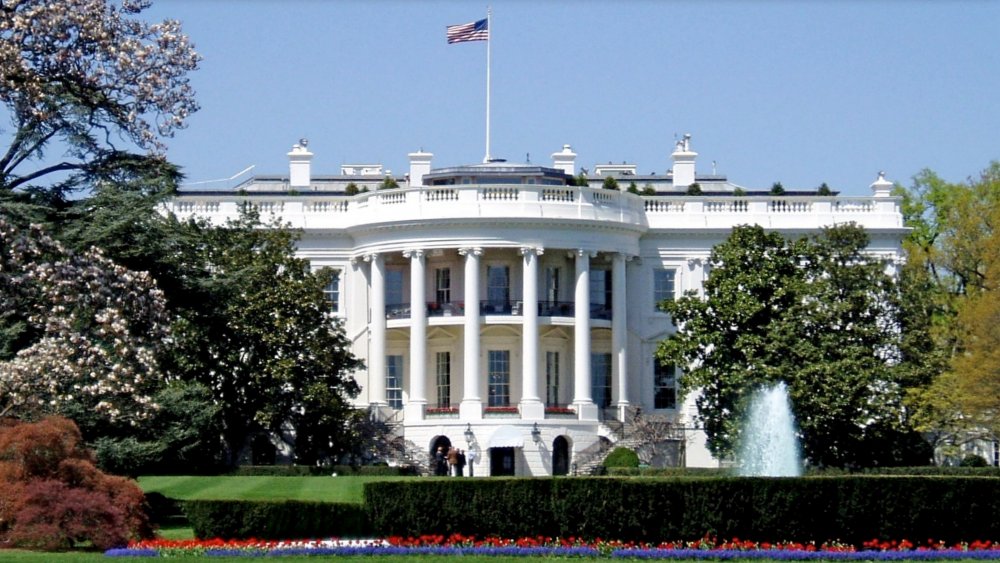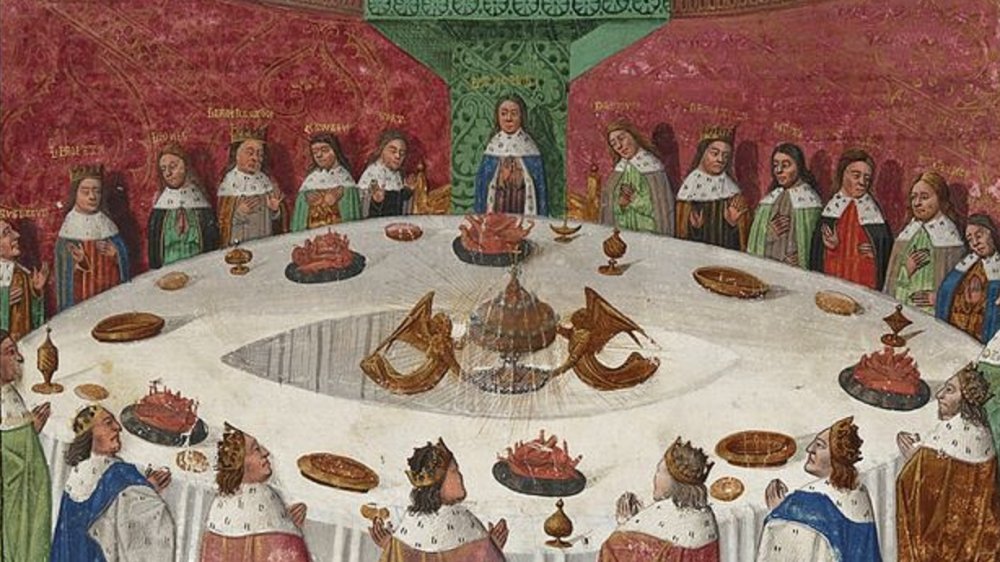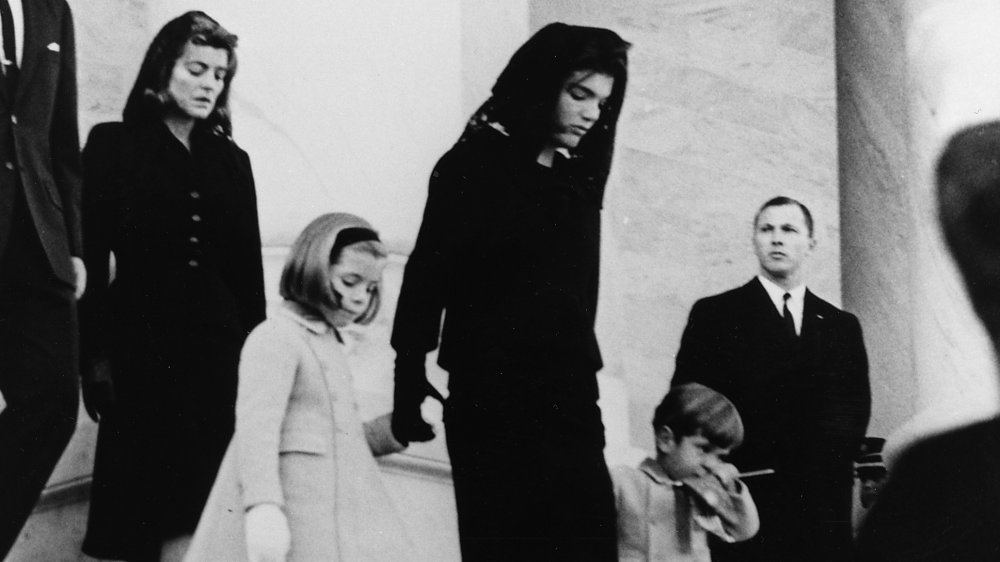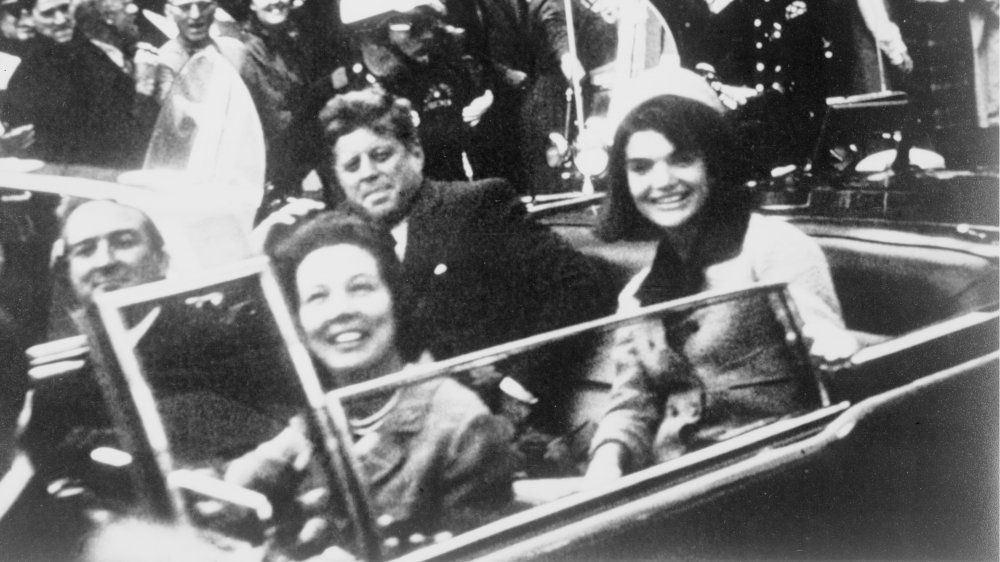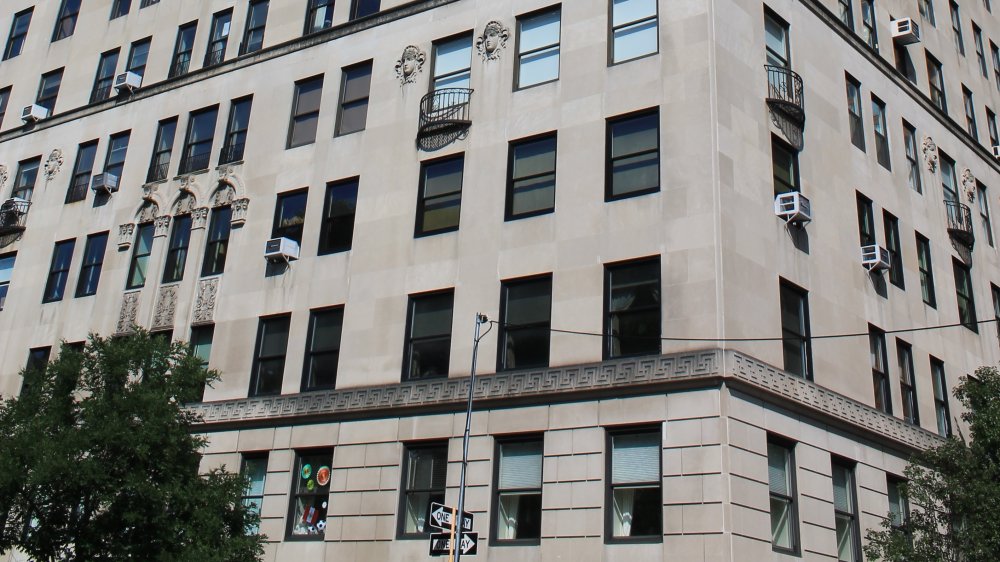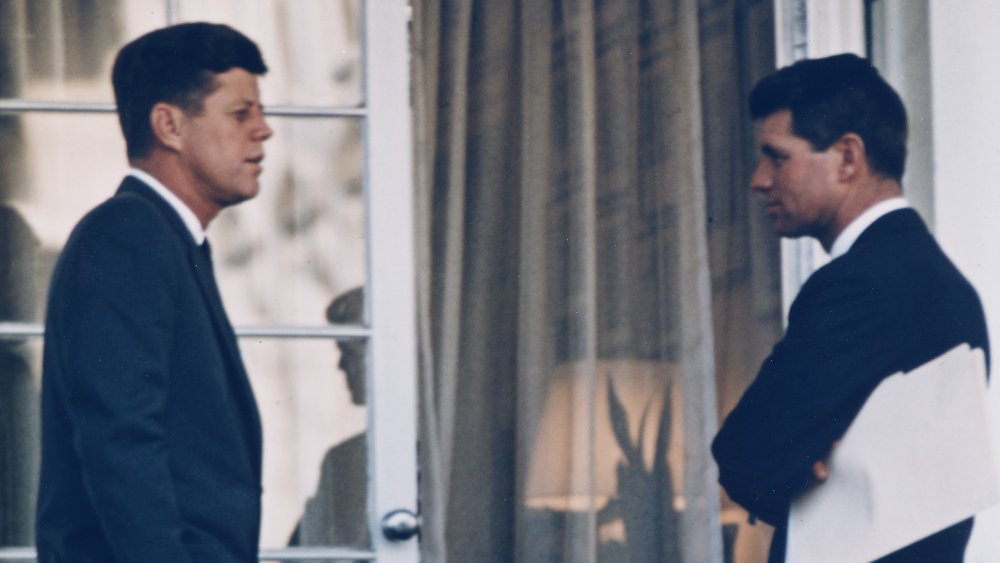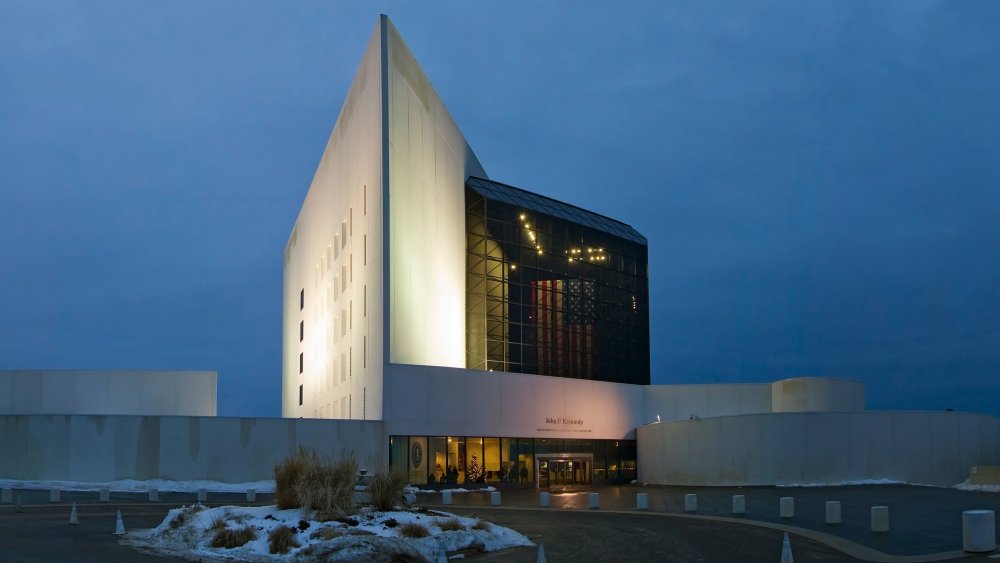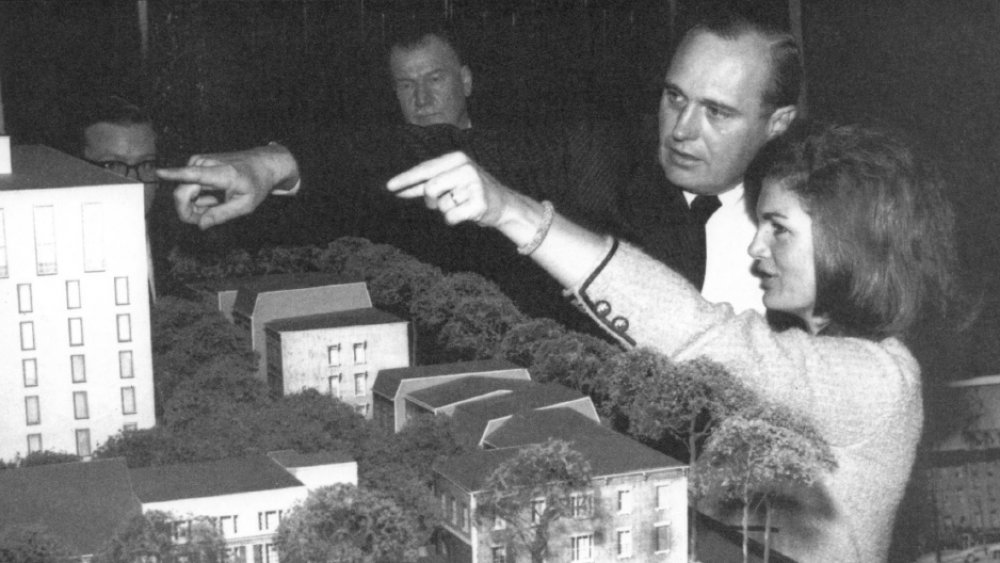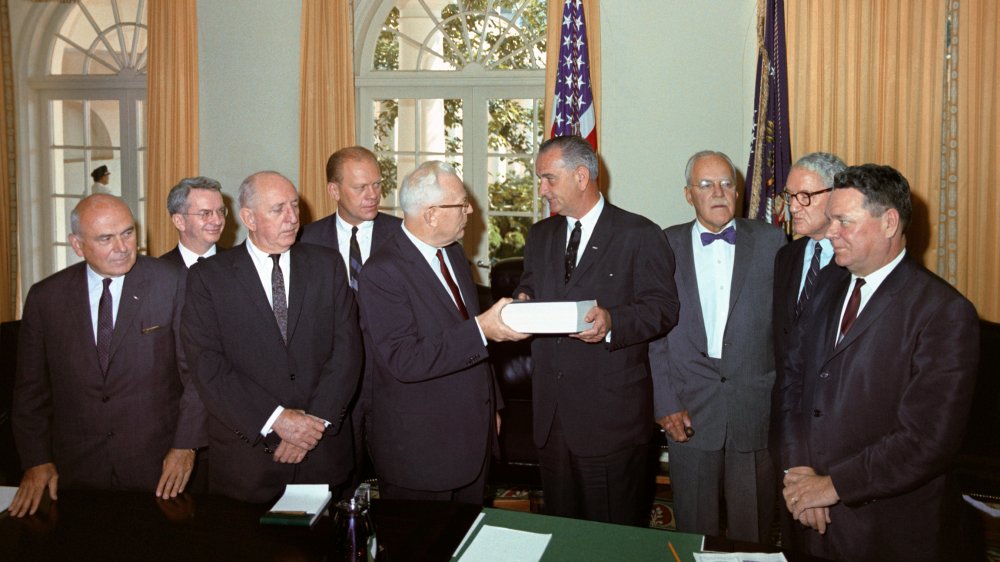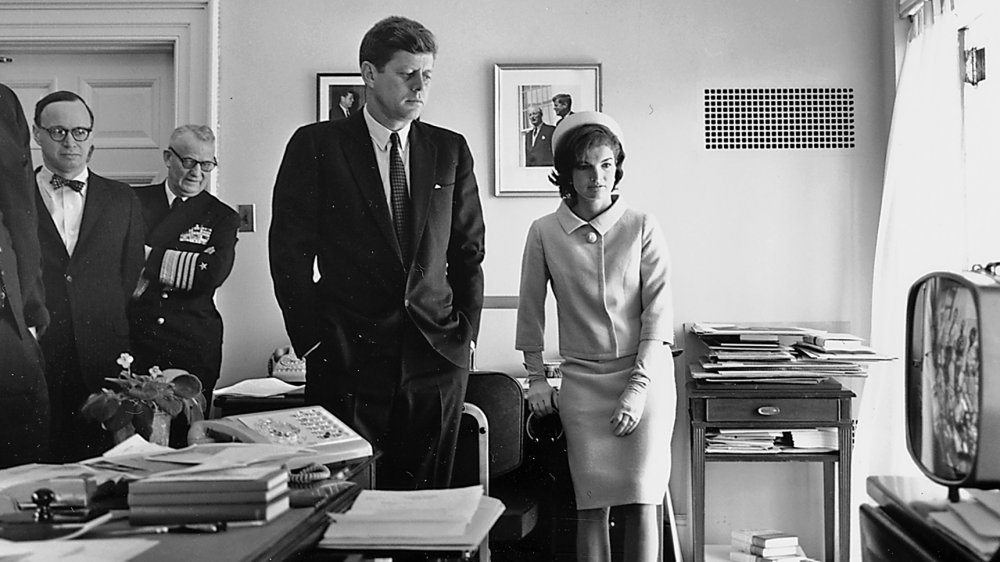What Jackie Kennedy Did The Year Following JFK's Death
When John F. Kennedy became the youngest person ever to be elected President in 1960, he was seen as a breath of fresh air. His wife Jacqueline Kennedy (better known as Jackie) was also a different kind of First Lady. Elegant, stylish and charming, she'd studied for a year at the famous French university the Sorbonne and spoke fluent French, and had worked as a reporter and photographer after graduation. She and John met in 1951, when he was a Massachusetts congressman, and married two years later. Despite his affairs, Jackie was extremely dedicated to him. She even refused to leave him and go to a bunker during the Cuban Missile Crisis.
On November 22, 1963, John and Jackie visited Dallas as part of his upcoming reelection campaign. It was Jackie's first extended public appearance since their newborn baby Patrick had died that August. The couple rode in a car with Governor John Connally and his wife Nellie. At around 12:30pm, as they turned onto the Main Street at Dealey Plaza, Lee Harvey Oswald shot and killed Kennedy from the Texas School Book Depository across the street. (Connally was also hit but survived.) Jackie became the world's most famous widow. But while she was praised for her strength in public, in private she was devastated. This is what Jackie Kennedy did the year following JFK's death.
Jackie Kennedy insisted on being present at Lyndon Johnson's swearing in
Although John F. Kennedy was likely already dead when he arrived at Dallas' Parkland Memorial Hospital, doctors whisked him into Trauma Room 1 and tried chest compressions. Jackie refused sedatives, and insisted on being with her husband. As a priest administered the last rites, she slipped her wedding ring onto his finger. A few weeks later, LIFE reported that President Kennedy's assistant Kenny O'Donnell had retrieved the ring and returned it to Jackie, correctly believing that she might regret being without it.
Kennedy's body was taken to Air Force One at Love Field Airport in Dallas, where new President Lyndon Johnson was waiting. He'd been advised to fly back to Washington, D.C. to be sworn into office officially, but refused to leave without Jackie, and she refused to leave without Kennedy's body. Johnson's wife, Lady Bird Johnson, gently asked Jackie if she'd like to change out of her blood-spattered clothing: the famous pink "Chanel" suit that was not Chanel but an American copy. Jackie said no: "I want them to see what they have done to Jack." It was her idea to stand beside Johnson as he was sworn in. According to Esquire, when O'Donnell asked her if she was sure, she told him, "I think I ought to. At least I owe that much to the country."
Jackie planned Kennedy's funeral meticulously
Jackie wanted her husband's funeral to symbolically associate him with another slain President: Abraham Lincoln. Kennedy was laid in state in the Capitol's Rotunda on November 24, on the same catafalque that had been used for Lincoln's body in 1865. According to the White House website, 250,000 people visited to pay their respects.
The next day, the casket was carried by caisson to the White House. From there, Jackie decided that she and the children should walk behind it, to Mass at St. Matthew's Cathedral, according to Business Insider. The journey also included a riderless horse with empty boots facing backwards in his stirrups: a symbol of a lost military leader. After Mass, Kennedy's body was transferred back to the caisson for the journey to Arlington Cemetery. You may have seen the famous photo of his son John Jr. (Jack Jack) saluting the casket. In footage showing the moment, you can see Jackie bending down to remind her son to salute his dad and say goodbye.
Jackie had overcome much resistance to have an eternal flame installed at Arlington, which she, Bobby, and Ted Kennedy lit in turn. After the internment, she hosted a small reception back at the White House. Secret Service Agent Clint Hill told Town & Country that Jackie and Bobby secretly visited the grave again at midnight, where she laid down her own small bouquet of flowers.
Jackie Kennedy tried to avoid the White House
The Johnsons refused to rush Jackie out of the White House, and stayed in touch after she left, according to ABC News. But Jackie didn't want to stay in the home that was so tied to Kennedy and the Presidency.
Initially, Jackie took the children to Cape Cod, while staff packed up their stuff at the White House. They returned on December 2 and moved out for good on December 6, to a house in Georgetown, Washington D.C., that belonged to Undersecretary of State W. Averell Harriman. Vanity Fair reports that it was only three blocks away from the house where she and Kennedy had been living when he was elected President. A couple of months later, Jackie bought a house over the road, and had the decorator design the children's bedrooms to mimic the ones they'd had at the White House.
Despite numerous invitations from President Johnson and later Hillary Clinton, Jackie avoided the White House for almost the rest of her life. According to the Washington Post, she even asked drivers to take routes away from it. She returned only once, for a secret visit in 1971 at the request of President Richard Nixon, to view the official portraits of her and Kennedy by Aaron Shikler, and take a tour with First Lady Pat Nixon. She later described the trip as, "one of the most precious [days] I have spent with my children."
Jackie coined the phrase people still associate with Kennedy's White House
The day after Thanksgiving 1963, Jackie summoned Theodore H. White — a historian who had studied American Presidents, including Kennedy — to see her at the Kennedys' estate in Cape Cod, because she wanted to give an interview for Life magazine. White managed to convince his editors to hold off going to press (at a cost of $30,000 an hour, according to the New York Post) so they could print her interview. He drove there himself, in the middle of a raging storm, to get Jackie's still-raw perspective on her husband's death and his legacy.
Jackie told White that although Kennedy had always loved classical art, the line she kept coming back to when trying to sum up his tragically abbreviated Presidency was from the musical comedy "Camelot." According to Jackie, Kennedy's favorite line was "Don't let it be forgot/That once there was a spot/For one brief shining moment that was known as Camelot." She explained, "There'll be great Presidents again... but there'll never be another Camelot again."
The issue was published on December 6, the day Jackie, Caroline and John Jr. moved out of the White House. Just as Jackie hoped, the Kennedy White House is still described (accurately or not) as Camelot, meaning a place where noble-minded men come together to plan out schemes that will make the world better.
Jackie thanked the nation for its condolences — but struggled to be a symbol of grief
After Kennedy's death, Jackie was widely praised for the incredible grace and strength she showed to the world. Lady Bird Johnson, for example, was impressed and a little intimidated at how Jackie carried herself with so much poise under immense stress. In her diary from November 24, Lady Bird recalled driving from the White House in a limousine with President Johnson, Jackie and her two children, and Bobby Kennedy, past weeping mourners lining the road. Lady Bird wrote that only "the dignity of Mrs. Kennedy and the members of the family" prevented her from crying too.
On January 14, 1964, Jackie addressed the nation in a newsreel, thanking them for the messages of condolence — "nearly 800,000 in all." She said, "The knowledge of the affection in which my husband was held by all of you has sustained me."
Jackie had been raised not to make a fuss in public, and according to Vanity Fair she was irritated at the praise she received. Behind the scenes, she was, understandably, an emotional wreck. The crowds that gathered wherever she went scared her — they reminded her of Dallas — and she didn't feel up to bearing the weight of a nation's grief, coupled with her own and her children's.
Jackie Kennedy may have had PTSD
Although the public saw Jackie as a symbol of dignified grief, in private, she was deeply depressed and traumatized. Based on testimonies of people who knew her, Vanity Fair suggests that Jackie may have had post-traumatic stress disorder (PTSD).
It wasn't only the shock of losing Kennedy so suddenly: it was her proximity to his murder. Jackie had been inches away from him when he was struck by the fatal shot. As Lady Bird Johnson wrote, Jackie was "caked" with his blood when they met on Air Force One. In the hospital, according to the Washington Post, the chief of anesthesiology found her holding a piece of Kennedy's brain.
Vanity Fair reports that Jackie exhibited signs of PTSD in the period after the assassination. She struggled to sleep, self-medicating with alcohol, and spent a lot of time alone in her bedroom. She relived the moment Kennedy was shot over and over, trying to figure out if there was something she could have done to save him. She avoided anything that might remind her of what had happened: she couldn't even bear to have pictures of Kennedy in the house. Any slight reminder opened the floodgates of her grief, as she put it. We'll never know exactly what Jackie was experiencing. But it's true that her graceful public persona hid a devastating inner struggle.
Jackie Kennedy and her children moved to New York
A few months before the one year anniversary of the assassination, Jackie decided to leave Washington D.C. for New York. She hoped that she would be able to escape the public attention that followed her in the nation's political capital. In fall 1964, she bought an apartment on the 15th of 17 floors in 1040 Fifth Avenue, next to Central Park. After a vacation to the coast of then-Yugoslavia in July, in September she moved into the Carlyle Hotel while renovations on the apartment were underway.
This wasn't your average New York apartment. According to Vanity Fair, Jackie's new home came with four bedrooms, two dressing rooms, a library, three staff bedrooms, a living room, a dining room, a conservatory, a wine room, five bathrooms and two terraces.
On her first day in the city, Jackie took Caroline and John Jr. rowing on the lake in Central Park. She'd tried to give them some normalcy and happiness since their father's death. The previous December she'd put up Christmas lights and stockings, and she'd thrown John Jr. a belated party: they'd buried Kennedy on his son's third birthday. Moving to New York, Vanity Fair reported, she just wanted "to walk around the city, take taxis, do all the little daily things, without two [Secret Service agents] always following."
Jackie and Bobby Kennedy supported each other
The one person who may have been as devastated by John F. Kennedy's death as Jackie was his brother and Attorney General Robert (better known as Bobby.) Their shared grief solidified an already close friendship, even before Kennedy's body was back in Washington.
Esquire reports that when Air Force One landed with the newly sworn-in President Johnson and now-former First Lady Jackie Kennedy on board, Bobby pushed his way onto the plane looking for Jackie, and escorted her off ahead of the casket and of Johnson (who was not happy about this.) They would later be the last two people to see John in his casket, in the East Room of the White House, and would make a private visit to his grave after the formal funeral.
Jackie's personal assistant Kathy McKeon recalled that Bobby lived near Jackie's apartment in New York, and often visited. Of course there have been rumors about the nature of their relationship, with some suggesting they had a romantic affair. (Bobby was a notorious womanizer throughout his marriage to his wife Ethel.)
But Jackie's closeness with Bobby sometimes backfired: although she moved to New York to escape public attention, the Kennedys persuaded her to make appearances in support of her former brother-in-law's Senate campaign (which he won.) McKeon recalled that when Bobby was assassinated in 1968, Jackie was devastated, saying, "Same story all over again."
Jackie worked on the John F. Kennedy Presidential Library and Museum
John F. Kennedy had been contemplating his Presidential Library since 1961. A month before his death, he'd chosen a site for it in Cambridge, Massachusetts, near Harvard University. Less than a month after his death, Jackie joined members of his family to discuss the details of the Library, which was ultimately built near the University of Massachusetts Boston.
While in the White House, Jackie had taken charge of a restoration project that aimed to return the residence to its former glory. According to the Telegraph, she tracked down authentic period furniture, worked with renowned interior designers, and set up private foundations to fund her plans. She gave a televised tour of the newly revamped White House on Valentine's Day 1962, which was so popular it earned her an honorary Emmy.
Given this previous success, it makes sense that Jackie's main contribution to the Kennedy Presidential Library was an aesthetic one. In 1964, she selected Chinese-born architect I.M. Pei, who was seen as an odd choice by some. Jackie stuck firm: Vanity Fair reports that she argued that just like JFK when he was elected President in 1960, Pei had a lot of potential. Jackie also oversaw displays on family life in Kennedy's White House and was involved throughout the Library's slow progress: it finally opened in October 1979.
Jackie may have had an affair with the architect of her husband's memorial
Jackie was undeniably heartbroken over the death of her husband: but she may have looked for consolation with another lover. According to said lover, anyway.
Jackie fought to have an eternal flame installed at Kennedy's grave at Arlington National Cemetery. A temporary one was created in time for the funeral, and in the days after, she contacted architect John Carl Warnecke to work on a permanent memorial. Warnecke knew both Jackie and John: he'd worked on the restoration of Lafayette Square, and attended their private parties. (He claimed he also "took part in some of Jack's womanizing, too," according to the New York Daily News.) In a book published in 2009, author Edward Klein claimed that in the months after Kennedy's funeral, Warnecke's and Jackie's working relationship turned into a romantic affair. The only person who knew about it, apparently, was Bobby Kennedy, and he wasn't a fan. Vanity Fair reported that Warnecke claimed that Bobby banned him from applying to work on Kennedy's Presidential Library because of it.
If the affair did happen, it doesn't seem to have been more than a fling to Jackie. Biographer J. Randy Taraborrelli told People, "I don't think it was as serious for her as it was for him," and added that Jackie didn't want to get involved with Warnecke's money troubles.
Jackie testified to the Warren Commission about JFK's murder
One week after Kennedy's death, President Johnson appointed the President's Commission on the Assassination of President Kennedy — better known as the Warren Commission after its chair Chief Justice Earl Warren — to investigate. According to the National Archives, the committee heard testimony from 552 witnesses, including Jackie.
On June 5, 1964, Jackie was interviewed at her home in Washington D.C. by Warren, the commission's general counsel J. Lee Rankin, and Robert Kennedy in his capacity as Attorney General. The testimony lasted 10 minutes. Jackie said that the crowds in Dallas were very excited, and early in the route, Kennedy got out of the car to shake hands with a group of people. She said that she was looking to the left, away from Kennedy, when the first bullet hit him. That's what made her look round to see her husband holding his head. Then he collapsed onto her lap. Jackie didn't remember anything after that, including climbing onto the car, as can be seen in footage. She also said, "I used to think if I only had been looking to the right I would have seen the first shot hit him, then I could have pulled him down, and then the second shot would not have hit him."
The Warren Commission concluded that Lee Harvey Oswald was the lone gunman who killed Kennedy. But some people still argue there are bizarre things that never made sense about JFK's assassination.
Jackie Kennedy spoke to an interviewer for secret tapes
Jackie tried to control and avoid investigations into the details of Kennedy's assassination. She soon decided that she would authorize only one person to write an official account: William Manchester, an author she hadn't met, who had written a flattering book about Kennedy. Manchester signed a contract that gave Jackie final say over the book, but she spoke to him only a few times before deciding that reliving the moment over and over for him was too painful.
However, starting on March 2, 1964, Jackie spent over eight hours speaking to Kennedy's former aide and historian Arthur Schlesinger Jr., who was collecting interviews with people who had known Kennedy for his Presidential Library. The tapes were supposed to be sealed for 50 years, but in 2011, Jackie and Kennedy's daughter Caroline chose to publish them three years early.
Unsurprisingly, Jackie had nothing but praise for her late husband. She recalled him reading constantly, and his afternoon naps. According to the New York Times, she didn't hold back on certain other historical figures. She called French president Charles de Gaulle an "egomaniac," Martin Luther King Jr. a "phony," and India's future prime minister Indira Gandhi a "bitter, kind of pushy, horrible woman."
